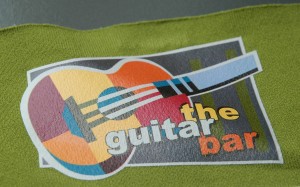Heat Printing

- Heat printed designs are crisp and colorful, but aren’t recommended when durability is a concern. They have a shiny, plastic looking appearance.
Overview
Heat or transfer printing is a decorating process which uses heat-applied transfers and a heat press to transfer designs and images onto garments. There is a wide variety of heat printing processes, such as transfer papers, plastisol/screen printed transfers, dye sublimation, and print/cut applications. There are a variety of methods used to produce heat transfers.
The ClassB heat printing method
The artwork
Artwork specifications for heat printing are similar to Digital printing as both methods allow for a higher resolution image. The artwork is prepared in as many colors as required and may contain photo-realistic images.
The transfer material
We use a 55 micron thick polyurethane transfer material which is lab certified with the highest rating for color fastness, rebound, and carries at 50 washability rating. It uses a patented adhesive for a superior bond. |
The ink
We use solvent based ink for a high quality print. There are four different ink colors – cyan, magenta, yellow and black. Those four colors combine to make the entire range of the color palette.
The printing process
Printing is done with a digital printer/plotter that first prints the image on the transfer material and then cuts the border for the transfer. It is a very precise process. Then the transfer is applied to the garment using a heat press to apply the proper pressure, temperature and time to properly seal the transfer to the garment. Once cooled, the garment is inspected and packed for shipping. |
Other Methods
While all heat printing uses a heat seal press, there are a large variety of transfer preparation processes.
Laser/Inkjet transfer paper
This is the simplest form of the heat printing processes. Special paper is fed through a laser printer or ink jet printer then trimmed by hand and applied to the garment. It is inexpensive and very quick. Unfortunately, it does not work well on dark fabrics and does not wash well.
Sublimation Transfer
In sublimation transfers, a special ink is used that, when heated, turns to a gas and dyes the fabric. Dye sublimation provides sharp, colorful images with a soft feel, allowing fabric to stay light and breathable. However, sublimation is limited to use on white or light-colored materials. Because the garment must be made of or coated with polyester, it is not an ideal method for use on garments. |
Plastisol Transfer
This is a process where standard screen printing techniques are used to apply the ink to a paper carrier. The ink is then partially cured and then applied using a heat press to finish the cure. It provides much of the benefits of screen printing without the equipment required to cure an entire garment. However, plastisol transfers are fragile and can be easily damaged by heat, light or abrasion. |
